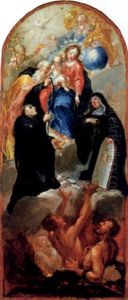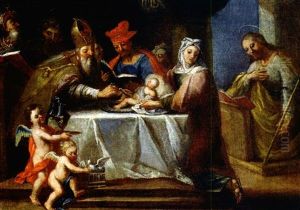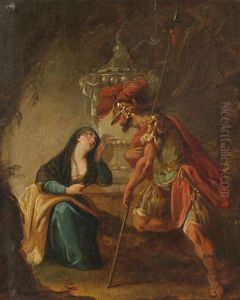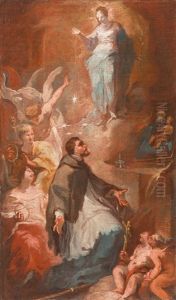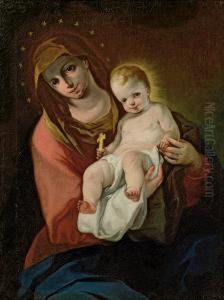Franz Joseph Spiegler Paintings
Franz Joseph Spiegler was a notable German Baroque painter, born in Wangen im Allgäu, present-day Baden-Württemberg, Germany, in 1691. His artistic journey began in the early 18th century, a period marked by significant developments in European art, particularly in the realms of Baroque and Rococo styles. Spiegler's work is often celebrated for its dynamic compositions, vivid use of color, and the emotional depth of its religious and mythological scenes. His contributions to the art of fresco painting and altar pieces in Southern Germany and parts of Austria are particularly esteemed.
Spiegler's artistic education and career were deeply influenced by the cultural environment of the Holy Roman Empire, within which he moved in circles that included some of the most prominent artists and patrons of his time. Though details about his early training are scant, it is known that he traveled extensively in his youth, a common practice among artists of the period seeking to complete their education through exposure to different styles and techniques. These travels likely included stays in important artistic centers such as Italy, where the Baroque style originated, and which had a profound impact on his work.
In the 1720s, Spiegler's career began to flourish. He received commissions for church frescoes and altarpieces, demonstrating not only his mastery of large-scale compositions but also his ability to imbue these religious subjects with a sense of immediacy and emotional intensity. His works from this period, many of which adorn churches and monasteries in Southern Germany, are characterized by their dramatic lighting, lively figures, and detailed landscapes, all of which demonstrate the influence of Italian Baroque, albeit filtered through Spiegler's unique perspective.
Among Spiegler's most significant contributions to the art world are his frescoes in the Imperial Abbey of Ochsenhausen and the pilgrimage church of Steinhausen, the latter being considered a masterpiece of the German late Baroque period. His work at Steinhausen, in particular, showcases his skill in creating a heavenly vision that is both awe-inspiring and accessible, a hallmark of the most effective religious art of his time.
Franz Joseph Spiegler died in 1757 in Wiesensteig. His legacy is that of a pivotal figure in the development of Baroque painting in Southern Germany, bridging the grandeur of Italian Baroque with the emerging sensibilities of the Rococo. His works continue to be studied and admired for their artistic and historical significance, offering insights into the cultural and spiritual life of 18th-century Europe.




